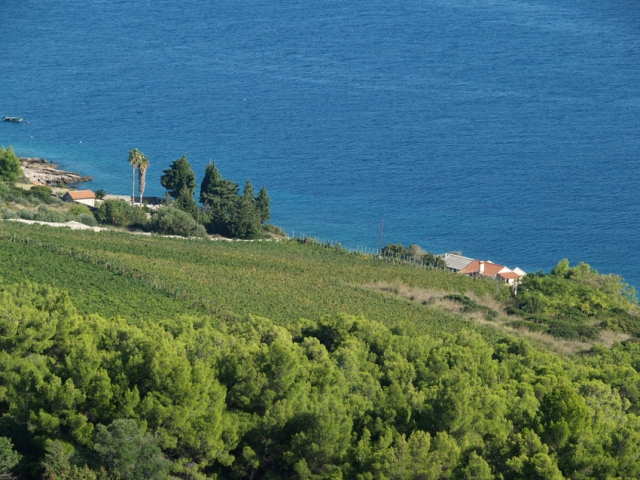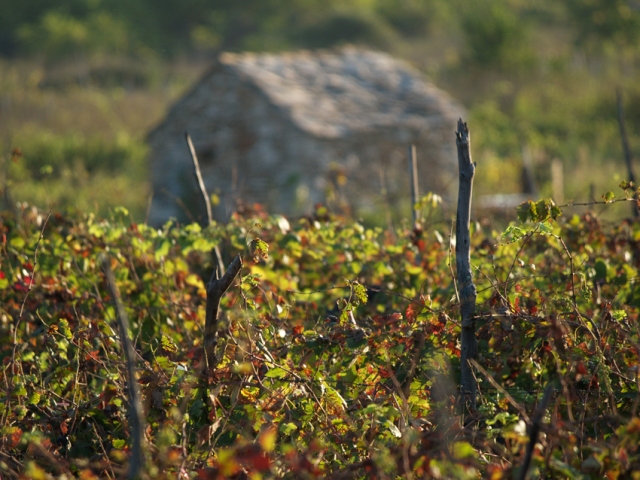Crljenak Kaštelanski arrives in the U.S.
 |
The almost extinct Dalmatian grape varietal Crljenak Kaštelanski has been resurrected and replanted by one of Croatia’s top winemakers, Zlatan Plenkovic (www.zlatanotok.hr). The first shipment of Zlatan Crljenak arrived in the U.S. two weeks ago!
The historic varietal Crljenak Kaštelanski, aka Croatian Zinfandel, together with another old Dalmatian grape called Dobricic are the parents of Plavac Mali, the most popular red grape variety in Dalmatia today. Zlatan Crljenak comes from Plenkovic’s vineyards in Makarska. It is a vibrant, youthful and very intriguing Croatian Zin.
|
Imported by VinumUSA www.vinumusa.com
Distributed in CA by Blue Danube Wine www.bluedanubewine.com
Zlatan Crljenak is currently available in the U.S. from the following retailers:
Madison Wine Cellar - Madison, NJ, Tel. (973) 377-4075
http://www.madisonwinecellar.com
Fermented Grapes - Brooklyn, NY, Tel (718) 230-3216
http://www.fermentedgrapes.net/
Broadway Wines, Astoria NY Tel (718) 278-4099
Cypriana Wine - Astoria, NY Tel. (718) 278-3400
K&L Wine Merchants - San Francisco, CA, Tel. (877) 559-4637
http://www.klwines.com/
Silverlake Wine - Los Angeles, CA, Tel (323) 662-9024
www.silverlakewine.com
Looking for Zinfandel in Croatia
Dr. Carole Meredith, Department of Viticulture and Enology, University of California, Davis
Zinfandel-America’s own grape, right? Well, sort of, but you knew already that it’s originally from somewhere in Europe.Is it Italy? You heard that somewhere. But wait, didn’t you read something about Croatia too. Are you confused yet? Here’s the latest on what’s now known about where Zinfandel came from, straight from the source-the intrepid international Zinquest Expeditionary Force!
Yes, it’s true. Primitivo, the grape grown in the boot of Italy, is indeed the same variety as Zinfandel.There’s no question about that now. But that doesn’t mean that Zinfandel and Primitivo are absolutely 100% identical. There are some subtle differences between the Zin grown in California and the Primitivo grown in Puglia, but they’re clonal differences, just like the differences that exist between clones of Pinot noir or Syrah. Zinfandel and Primitivo are synonyms for the same variety, like Brunello and Sangiovese or Tempranillo and Valdepeńas.
So is Italy the home of Zinfandel, aka Primitivo? In a word, no.The grape has been in southern Italy for only 150 to 250 years, a long time by New World standards but merely an eyeblink in the long wine history of the Mediterranean region. Some historical records suggest that it was brought to southern Italy by monks who came from what we now call Croatia, just across the Adriatic Sea from Puglia.
Those interested in the origins of Zinfandel have long wondered about Croatia.While the inland part of Croatia has a harsh continental climate, the Dalmatian Coast is typically Mediterranean in climate and in culture. Fresh fish, mussels, olives, and plenty of red wine are the staples of the Dalmatian diet. The best wines along the Dalmatian Coast are made from a grape called Plavac Mali, which looks suspiciously similar to Zinfandel.

In 1998 I went to Croatia to take a closer look at Plavac Mali and to collect samples to bring back to Davis for DNA comparisons with Zinfandel.This was a trip that fell together beautifully. First, Mike Grgich offered to help by providing accommodations and some contacts. Then, a Croatian researcher from the University of Zagreb,Ivan Pejic,contacted me to ask for assistance in launching a research project aimed at learning more about old Croatian grape varieties. He had no idea that I was planning a trip to Croatia for much the same purpose! To add to that, Jasenka Piljac, a young Croatian woman who had worked part-time in my UC Davis research lab while she was an undergraduate biochemistry student, was returning to Zagreb and was available to be my assistant, guide and (most importantly!) translator during the trip. Her family’s roots are on the Dalmatian Coast so this project was dear to her heart.
In May 1998, Ivan, his colleague Edi Maletic, Jasenka and I, aided by local experts in some places, went to lots of Plavac Mali vineyards along the coast and on some of the larger coastal islands. Some of those vineyards were so steep that we literally climbed through them, holding onto vines to keep from sliding into the Adriatic! I returned to Davis with 150 samples to analyze. My assistant Jerry Dangl and his crew purified DNA from each of the samples and analyzed it.
By fall of 1998, with the DNA results in, it was obvious to us that Plavac Mali was definitely NOT Zinfandel. But it wasn’t completely unrelated either. What became apparent was that Plavac Mali and Zinfandel shared considerable family history, so much so that Plavac Mali could have been one of the parents of Zinfandel or vice versa.
Each year after that,as the grapes ripened in the fall, Ivan Pejic and Edi Maletic continued to comb the Dalmatian Coast, poking around in old vineyards, especially the more remote ones on the coastal islands. They were not only looking for Zinfandel, but also for other interesting old varieties threatened with extinction so that they could preserve them as part of Croatia’s viticultural heritage.They would gather samples of everything that looked interesting that they hadn’t seen before and send them to us in Davis.We would analyze the DNA in the lab and report back to them. Edi and Ivan found lots of interesting varieties but no Zinfandel. Many of the varieties were obviously relatives of Zinfandel, though, reinforcing our idea that Zinfandel was a Croatian grape, even if we couldn’t find it there today.We speculated that maybe Zinfandel no longer existed in Croatia because it had been wiped out by phylloxera.
In fall 2000, Ivan and Edi collected more samples and sent them to us for analysis.One of them proved to be particularly interesting. It’s a variety called Dobricic, a very old variety grown almost exclusively on the island of Solta. By June 2001, we had discovered that, just like Zinfandel, Dobricic is also closely related to Plavac Mali. In fact, Zinfandel and Dobricic appear to be the parents of Plavac Mali.This further strengthened the case for a Croatian origin for Zin and, furthermore, it meant that Zinfandel was even older than Plavac Mali, itself thought to be a very old grape.
At that point, Ivan and Edi thought they had probably uncovered all the old Dalmatian grapes they were likely to find.We prepared to put together a case for the Croatian origin of Zinfandel based on circumstantial evidence, even though we hadn’t actually found Zinfandel itself. We had found a lot of old Croatian varieties that were related to Zinfandel and, furthermore, Zinfandel was very likely a parent of Croatia’s most distinguished old wine grape, Plavac Mali.

In fall 2001, Ivan and Edi made one last expedition. The funding for their viticultural heritage work was running out but they wanted to go back to a few vineyards to try to reconcile some ambiguous results we had obtained the year before. By now, Ivan was equipped to do some DNA analysis in his own laboratory in Zagreb so he didn’t need to send the samples to us in Davis. In early December, Ivan sent me an email that was full of exclamation points! His preliminary DNA results from one of the latest samples, a grape called Crljenak, showed that it matched Zinfandel! We’ve analyzed samples of Crljenak before, but Edi and Ivan say that this one is different than the others.
Edi and Ivan sent a sample of this vine to us so we could do a more extensive DNA analysis in our Davis lab.We’ve just finished the work and yes, it’s true. It IS Zinfandel!
Source:
http://www.zinfandel.org/about_zin/pdf/2002_01_Looking_for_Zin_in_Croatia.pdfFormatted for CROWN by Marko Puljić
Distributed by www.Croatia.org This message is intended for Croatian Associations / Institutions and their Friends in Croatia and in the World. The opinions / articles expressed on this list do not reflect personal opinions of the moderator. If the reader of this message is not the intended recipient, please delete or destroy all copies of this communication and please, let us know! Or simply...enjoy and spread the word and good vibrations.